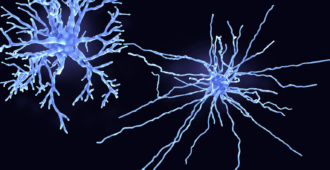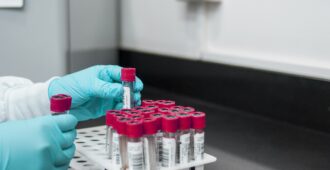On the last day of the 23rd International Symposium on ALS/MND in Chicago last week there was an excellent session on ‘the role of non-neuronal cells’ – it was an exciting session – below is a flavour of some of the topics discussed.
As its name suggests, motor neurone disease causes the degeneration of motor neurones – the long nerve cells that carry messages from the brain to the muscles via the spinal cord. But motor neurones don’t exist in isolation. Particularly in the last five years or so we have learnt a lot about the contribution of glia to the development of MND. In health, the different cell types that are collectively known as glia (eg astrocytes, microglia and oligodendrocytes) protect and support motor neurones. We know that this changes in MND. It’s an exciting and fast moving area of MND research, where there is lots still to find out. So it was a treat to have a session of the Symposium dedicated to the discussion of the latest results.
It opened with a great overview of what we know so far about the role of astrocytes in MND from Serge Przedborski. (Astrocytes are called astrocytes due to their star shape when seen down the microscope). Leading on from the studies showing that the medium (fluid) that astrocytes grow in can damage healthy motor neurones, he set out to find out whether astrocytes (and the chemicals that they emit) are toxic or whether there is a lack of benefit. (Bearing in mind glia are sometimes called ‘support’ cells – this comment about the lack of benefit is pertinent).
Using a clever assay, where it is pulled through a filter by spinning it, he showed that the astrocyte medium is toxic. So the next question was, what is it in the medium that makes it toxic? He and members of his lab looked at many possible components to check for their toxicity to motor neurones. The studies took over two years and were all negative “it’s too painful to list them all” he commented. “I had to change approach as I was risking the health of members of my lab!”
As he was describing the new approach I was reminded of the guessing game ‘animal, vegetable or mineral”. Is it a protein? was his first question, then the next was ‘is there an overall positive or negative charge to the protein?’ (some of the protein building blocks – amino acids – have a positive or negative charge, so the use of charge is a common way to separate them) and finally ‘how much does this protein weigh?’. The answers to these questions provided the first sort through before a second approach narrowed the search for the ‘toxic protein’ in astrocytes down to a choice of just nine possibilities. After looking at all nine in more detail, he found that a receptor on the surface of the astrocyte known as DR6 was responsible for its toxicity.
Dr Dan Blackburn from the Sheffield Institute of Translational Research, UK, described another approach to uncovering clues about why astrocytes are toxic – using an approach that looks at which proteins are made at a particular time called ‘gene expression’ profiling.
Although the genes in each cell are there all the time, they are not read all at once. (In the same way that you won’t try and make every single dish in your recipe book simultaneously). So looking at which genes are read (known as gene expression) over the course of the disease leaves a detective trail to find out what caused the motor neurones to die.
Following on from earlier work in their lab, Dr Blackburn presented the trail of evidence from when a mouse model of MND first begins to show symptoms, and from a later time point, when the disease is far more advanced. He pointed the finger at abnormalities in cholesterol transport.
After you’ve finished reading the symposium articles that interest you, we’d be grateful if you could spare a few minutes to fill in our short online survey on our symposium reporting. Your comments really are useful and allow us to continually improve our symposium reporting. surveymonkey.com/s/alssymp






Comments are closed.